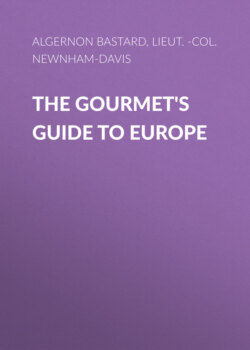Читать книгу The Gourmet's Guide to Europe - Lieut.-Col. Newnham-Davis - Страница 6
На сайте Литреса книга снята с продажи.
Across the River
ОглавлениеOn the south side of the Seine there are three restaurants worthy the consideration of the gourmet—the Tour d'Argent, La Peyrouse, and Foyot's. The Tour d'Argent is on the Quai de la Tourelle, just beyond the island on which Notre Dame stands. It is a little old-fashioned place with a narrow entrance hall and a low-ceilinged parlour. Frederic is its proprietor, and since Joseph of the Marivaux died Frederic remains the one great "character" in the dining world of Paris. In appearance he is the double of Ibsen, the same sweeping whiskers, the same wave of hair brushed straight off from the forehead. He is an inventor of dishes, and it is well to ask for a list of his "creations," which are of fish, eggs, meat, and fruit, and are generally named after some patron of the establishment—Canapé Clarence Mackay, Filet de Sole Gibbs, Filet de Lièvre Arnold White, Œufs Claude Lowther, Poire Wannamaker, and so on. A marquis, M. de Lauzières de Themines, has written a long poem about Frederic, which is printed on the back of the list of "creations," and an artist has painted a portrait of the great man which will be shown to you if you have proved yourself a real gourmet. Madame Frederic, or his daughter, will hold the canvas for your inspection, and Frederic himself, brushing back his whiskers, will stand beside it in order that you may see what an excellent likeness it is. It is as well to interest Frederic in the ordering of your meal, and if you give him an idea of your requirements, he will select two or three of his "creations" which will make up a perfect meal. I always ask for a Filet de Sole Cardinal, which is one of his best dishes, and look to him to group a couple of other plats with it to make a perfect breakfast, for I look on the Tour d'Argent as being a better place to breakfast at than to dine at, owing to its distance from the centre of Paris. Frederic thinking out his dishes drops into a reverie and turns his eyes up to the ceiling. I once took a lady to breakfast at the Tour—she had selected it as being quite close to the Morgue, which she wanted to see after lunch, having a liking for cheerful sights—and she had the daring to interrupt Frederic's reverie. "And for the eggs?" I had said insinuatingly to the creator of dishes, and he had dropped into deepest thought. "Uffs à la plat," said the lady, who fancied we were both at a loss as to how eggs could be cooked. Frederic came back from the clouds and gave the lady one look. It was not a look of anger, or contempt, but simply an expression of pity for the whole of her sex. Frederic, as Joseph did, holds that a dinner to be good must be short, which is, I believe, the first axiom that every true gourmet should enunciate and hold by, and an excellent proof that he holds to his tenets was once given me. When the Behring Sea Conference sat in Paris, the American and English members used frequently to dine together after their labours. Lord Hannen had heard of the Tour d'Argent, and sent his secretary, a clever barrister, to order dinner there for all the members. He went to the Quai de la Tourelle, saw Frederic, and sketched out to him a regular Eaton Square dinner, two entrées, a joint, sorbet, game, an iced pudding, a savoury, and fruit. Frederic heard him out, and then very politely suggested that he should go elsewhere, for such a barbarous feast could not be served in the Tour d'Argent. If you are in great favour Frederic will cook you a dish himself, and will bustle into the room with the "creation" in his hands and great beads of perspiration, drawn out by the kitchen fire, on his broad brow. I am sorry, however, to have to write that the last time I saw Frederic, at the close of 1902, he was very ill. He complained of his chest, said that the weather oppressed him, and lamented the death of Joseph which had taken a friend and a brother artist away. His hair had lost its bold curve and his whiskers their glory. I told him in all sincerity that he must get over his malady, for that as there are so few "creators" and great maîtres-d'hôtel left we cannot spare one of the most original and most accomplished of them.
La Peyrouse on the Quai des Grands Augustins, is a little house with many small rooms. It is known to the students of the "Quartier" as "Le Navigateur." It is a favourite resort of the members of the Paris bar, has its special dishes, one of which is, as a matter of course, Filets de Sole La Peyrouse, and a most excellent cellar of Burgundies and white Bordeaux. The Cérons at 3 francs is excellent money's worth.
The Restaurant Foyot is almost opposite the Luxembourg Gallery, and is a very handy restaurant to dine at when going to the Odéon. Potage Foyot, Riz de Veau Foyot, Homard Foyot, and Biscuit Foyot are some of the dishes of the house, and all to be recommended. The anarchists once tried to blow up Foyot's with a bomb; but the only person injured was an anarchist poet, who has so far been false to his tenets as to dine in the company of aristocrats, and was tranquilly eating a Truite Meunière, in company with a beautiful lady, when his friends outside let off their firework. The hors-d'œuvre at Foyot's are particularly good. It is, however, a restaurant at which it is exceptionally difficult to get one's bill when one is in a hurry.
